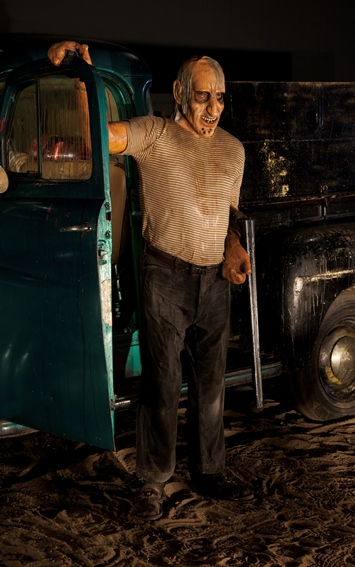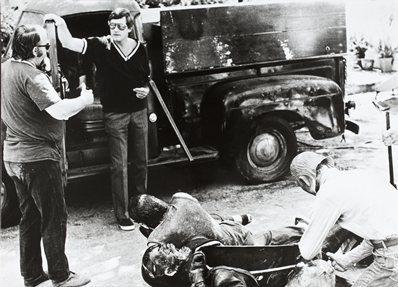In 1971, television host Keith Berwick interviewed Edward Kienholz at the artist’s studio during the making of Five Car Stud. During the interview, Kienholz made a plaster cast of Berwick’s body to be used as one of the figures in the artwork. I recently I had the chance to talk with Berwick to learn more about his experience.

Keith Berwick while interviewing Edward Kienholz for "Speculation: The World of Ed Kienholz" (1971), Photograph included in Documentation for "Five Car Stud Tableau and The Sawdy Edition," 1971 © Kienholz, photographs by John Romeyn, Bob Bucknam, Malcolm Lublinder, and Adam Avila
LACMA’s installation of Five Car Stud includes an introductory gallery putting the work in context. You figure into that preamble—a clip of your talk show with Edward Kienholz is prominently displayed.
That’s a great honor, I think! I remember the occasion quite vividly, although it was a long time ago.
How did your interview with Kienholz come about?
The [talk] show that I did at that time was called Speculation, on channel 28. One of the episodes was a program with Claes Oldenburg and Ed Kienholz. Ed was in a very surly mood during that program. He was an old friend of mine—I knew him and Lyn [Kienholz’s wife at the time] quite well—but he had come to the show and was very grumpy. He was not happy with the show. He said, “Look, if you really want to do a program with me, you should come to my studio and see the way I work and do something that’s natural, rather than this, which is very unnatural.” Price Hicks, who was my producer at the time, thought it would be a good thing to do.
We got up [to Ed’s place] very early in the morning and had a whole crew there. We spent the day doing what turned into a one-hour special. We did setups around his studio, and we went out to where he was working on Five Car Stud. By pre-arrangement with my producer, Ed prompted me to offer myself as one of the models. I was totally unaware that that was going to happen. It was a total surprise. I think it contributed to the energy of the occasion and the spontaneity. He had a robe for me; I stripped down and then came out, and he started lubricating me and putting on all this stuff. I was trying, through that impediment, to carry on a coherent interview with him!

Keith Berwick while interviewing Edward Kienholz for "Speculation: The World of Ed Kienholz" (1971), Photograph included in Documentation for "Five Car Stud Tableau and The Sawdy Edition," 1971 © Kienholz, photographs by John Romeyn, Bob Bucknam, Malcolm Lublinder, and Adam Avila
Were you apprehensive when he proposed casting you in his artwork?
My initial reaction was to think that this was a great joke at my expense. I was not accustomed to standing around in my underwear in public! So there was a level of apprehension to it. But on the other hand, I very well understood that this was what we were going to do. I certainly recognized that it was going to be fun to do and that it might even make good television.
What was the nature of interview? Was it about Five Car Stud or was it intended to be more broad?
It was an attempt to allow people to become acquainted with Ed Kienholz as a commentator on the human condition through his craft and through his pack-rat tendencies and bargaining—to reveal the whole repertoire of Ed Kienholz’s idiosyncrasies that made him such a significant force. This was an attempt to simply give him the opportunity to be Ed Kienholz and to reveal himself as fully as he would be willing to do. And if revealing myself in the way that I was doing would help that, I was perfectly willing to do it.
Was Five Car Stud far enough along that you understood what the piece was going to be?
Ed didn’t go in for subtlety. He may have incorporated a lot of nuance, but that piece, like all of his others, was in your face. There wasn’t any doubt about what was being portrayed and what the significance of it was. It was as graphic in its way, and for that message, as Back Seat Dodge '38 was. Ed was engaging questions of the ugliness of race and racism in ways that others were not at that time.

Edward Kienholz, “Five Car Stud 1969–1972, Revisited,” Installation view (detail), photography by Tom Vinetz, © Kienholz, collection of Kawamura Memorial Museum of Art, Sakura, Japan, courtesy of L.A. Louver, Venice, CA and The Pace Gallery, New York
What was your feeling, after having been a participant in the making of an artwork, when you saw the finished product?
Let me just tell you that I was very much dismayed that he had added fifty to seventy-five pounds to the [cast of the] figure that I had portrayed. That was sort of a nasty trick. I didn’t at all mind that my head had been replaced by one his masks, but vanity caused me some dismay over seeing the added weight [laughs].
More to the spirit of your question: I find it a horrific piece, and a very sobering piece. I persist in thinking that it was one of those prods to the conscience that Ed was so gifted at creating, which made him a significant force.
Knowing Ed and his work so well, what is your feeling on the fact that forty years later the artwork is finally being presented to the American public?
I think in one sense that it’s long overdue, which is obvious. But in another sense, I think that it’s peculiarly apposite to the time that we’re in because I believe there is an ugly undertow of racism in society today, which has been particularly evident in the political sphere since the Obama campaign in 2008, and is revealing itself in a lot of ways that makes me acutely uncomfortable. Under the guise of political ideology and a concern for economics, racism is manifesting itself in very ugly ways. I think that the more that can be done to confront us with this and cause us to recognize it and reflect upon it, particularly those people who may be conscious of what you might call “unconscious racism”—people who do not regard themselves as racist but who, in any reasonable determination, are racist. And that includes lots of people who think of themselves as extremely enlightened in these matters.
To be very candid about it, I think that the mission of LACMA is precisely to explore these matters of vital concern to the larger community. I hope that one of the effects of that is to bring to LACMA many people who would not otherwise come.
Scott Tennent



